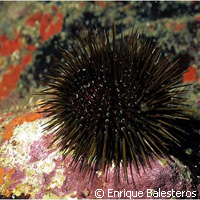Can sea urchins survive giant seaweed invasion?
Sea urchins (Paracentrotus lividus) in the Mediterranean seabed are currently in the throes of a battle for survival in the face of exotic marine species that are spreading into their habitat and threatening its biodiversity. But while the humble sea urchin is harnessing all its energy to fend off these exotic predators, mainly giant seaweeds, its ability is limited and can only stretch so far. Its battle for survival was the focus of a new EU-funded study published in the journal Biological Invasions, which investigates native herbivores and their resistance to Mediterranean marine bioinvasions. A team of researchers from Spain's University of Girona, University of Barcelona, Centre for Advanced Studies of Blanes (CEAB), and Mediterranean Institute for Advanced Studies investigated how effectively the sea urchin can limit the invasion of two seaweeds, Lophocladia lallemandii and Caulerpa racemosa. The study, which was supported in part by Marie Curie Fellowship under the 'Mobility' Thematic area of the Sixth Framework Programme (FP6), found that sea urchins were only able to resist the seaweed's effects during the early stages of its invasion or when densities were very low. 'After seven months of experimentation, we found that predation by these herbivores had no effect once Caulerpa racemosa was completely established, although it did reduce the degree to which it became established in the very early stages of invasion,' says lead author of the study, Emma Cebrián. The researcher also explains how the sea urchins were able to limit the seasonal spread of the seaweed Lophocladia lallemandii: 'Since the amount of this species directly consumed by the sea urchins is very low, this reduction was due more to the decline in other native species (consumed by the sea urchins), which act as a substrate for the seaweed.' These findings mean that despite the sea urchins' ability to limit the effect of invasive seaweed when they are gathered in high-density groups, they are powerless in areas where the seaweed is already well established. The researchers also used the experiment to compare the proportion of invasive seaweeds in the environment and the amount actually consumed by the sea urchins. They found that the sea urchins are in fact quite picky, consuming invasive seaweed according to their preferences rather than availability. Despite both seaweed types being present in the sea urchins' habitat, Lophocladia lallemandii was consumed to a very low degree, while Caulerpa racemosa proved to be very popular. To find out whether consumption by the sea urchins could control the invasion by these two species, the team of researchers placed large numbers of sea urchins into cages and monitored how the invasive seaweeds developed. The cages were placed in areas already completely invaded by Caulerpa racemosa, in areas where the invasion was still very limited and in places where Lophocladia lallemandii was very abundant. 'The sea urchins only controlled the expansion of Caulerpa racemosa in the cages in places where the invasion was still at a very early stage,' comments Emma Cebrián. Now the team plan to look into developing ways of controlling these exotic species' invasions, something which would contribute to the overall health of Mediterranean biodiversity.For more information, please visit:University of Barcelona:http://www.ub.edu/web/ub/en/
Countries
Spain



